
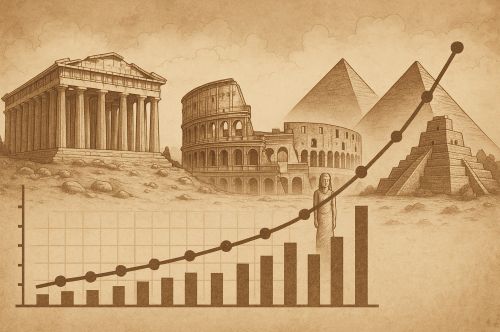
Civilizations rose to remarkable heights of density and urbanization, yet they did so within limits that could quickly unravel.

By Matthew A. McIntosh
Public Historian
Brewminate
Introduction
To count the dead is difficult; to count the living in antiquity is harder still. Ancient demographics remain elusive because the evidence is fragmentary and often indirect. Numbers rarely come to us as neat census tables. Instead, they emerge from shards of papyri, temple inscriptions, archaeological footprints, and skeletal remains. Yet the attempt to measure ancient populations matters, for demographics reveal not only the scale of human settlement but also the limits of ancient economies, the resilience of communities, and the fragility of pre-modern life.
This essay traces population growth and demographic patterns across the Mediterranean and Near East, South and East Asia, Africa, and the Americas. Each region presents distinctive evidence, but the challenges remain consistent: high fertility rates balanced by high mortality, populations clustered around fertile agricultural zones, and cycles of growth checked by famine, war, and disease. While the exact numbers are uncertain, the broad rhythms of expansion and contraction can still be reconstructed.
Methods and Limits of Evidence

Archaeology offers the most visible entry point. Settlement density, the size of houses, and the spread of field systems hint at the number of inhabitants who once lived in a given landscape.1 In some cases, archaeologists can trace demographic shifts by examining the expansion of village perimeters or the abandonment of marginal lands during times of stress.
Texts, when they survive, provide sharper edges. The Roman census counted citizens for taxation and military service, while Chinese dynasties compiled household registers to secure control over vast populations.2 These documents rarely tell the whole story (children, women, or slaves might be undercounted or excluded) but they offer invaluable starting points.
Skeletal remains also speak, though often in whispers. Patterns of enamel hypoplasia, bone lesions, and burial distributions can suggest infant mortality rates and average lifespans. Paleodemography reconstructs age pyramids from graveyards, revealing a world where half of all children might die before reaching adulthood.3
The greatest danger lies in precision. Ancient numbers are often cited as though definitive, yet in truth they are ranges with wide margins of error. To imagine Rome as a city of one million people is plausible but not certain; to cite it as fact is an act of historical confidence rather than evidence.
The Mediterranean and Near Eastern Worlds
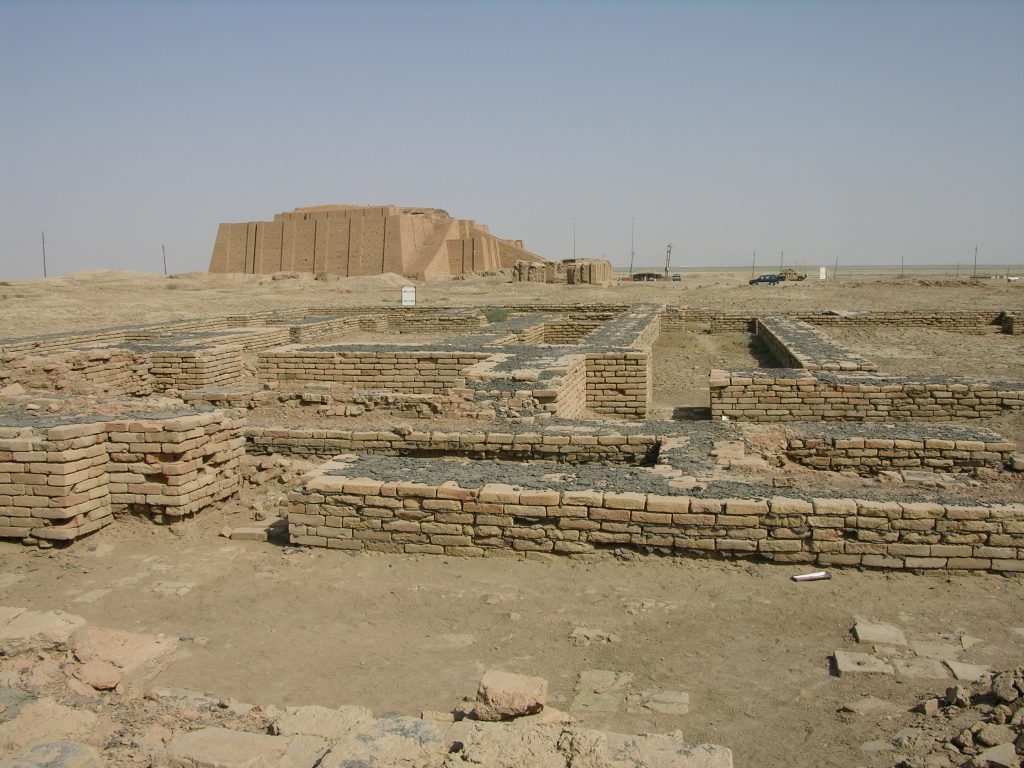
In Mesopotamia, population growth was tied to the irrigation networks that sustained urban centers like Ur and Babylon. Scholars estimate that by the early second millennium BCE, the southern plains could support several hundred thousand inhabitants, clustered in city-states surrounded by dense agricultural zones.4 But these systems were precarious, dependent on canals that required constant maintenance. Salinization of fields sometimes forced contraction as surely as conquest did.
Egypt offers a clearer rhythm, for the Nile flood set the limits of demographic expansion. Good inundations yielded abundant harvests and steady growth; poor floods brought famine. Estimates for Pharaonic Egypt range from 2–4 million people in the Middle Kingdom to perhaps 5 million under the Ptolemies.5 Cities like Thebes and Alexandria became hubs of density, though the countryside remained the demographic heart.
Classical Greece presents a more fragmented picture. Each polis maintained its own citizen rolls, but these excluded slaves, metics, and women. Athens may have had 250,000 to 300,000 inhabitants at its height, with roughly half enslaved.6 War and colonization shaped demographic patterns as much as fertility. The Peloponnesian War, with its attendant plague of 430 BCE, sharply reduced Athenian numbers, a reminder that ancient growth was fragile.
Rome alone attempted systematization on an imperial scale. Censuses counted adult male citizens, but when allowances are made for women, children, and slaves, the total population of the empire in the early first century CE may have reached 60–70 million.7 The city of Rome itself may have swelled to between half a million and a million people, making it the largest urban concentration in the pre-modern world. Yet even Rome was vulnerable. The Antonine Plague (165–180 CE) may have killed millions, contracting the empire’s population and reshaping its labor markets.
South and East Asia

South Asia’s demographic story begins with the fertile plains of the Ganges. Archaeological surveys of early urban sites such as Pataliputra suggest that the Mauryan Empire could support tens of millions of people. The Arthashastra describes administrative machinery that presupposes significant population density, though exact figures remain elusive. Buddhist monastic records, with their lists of donations and households, provide indirect glimpses into the scale of communities.8
China, by contrast, gives us numbers of startling specificity. The Qin dynasty initiated censuses in the third century BCE, and the Han developed them into systematic tools of governance. Surviving records suggest a population of around 60 million by the first century CE, comparable to the Roman Empire.9 Household registration allowed the state to allocate taxes and corvée labor, making demography a foundation of governance itself.
Yet these numbers mask dramatic fluctuations. Wars, famines, and uprisings could slash populations in half. The collapse of the Western Han in 220 CE left registers showing sharp declines, though whether this reflected actual deaths or unrecorded households remains debated. Still, the broad arc is clear: demographic growth was possible only when agricultural productivity and political stability aligned.
Africa Beyond the Nile
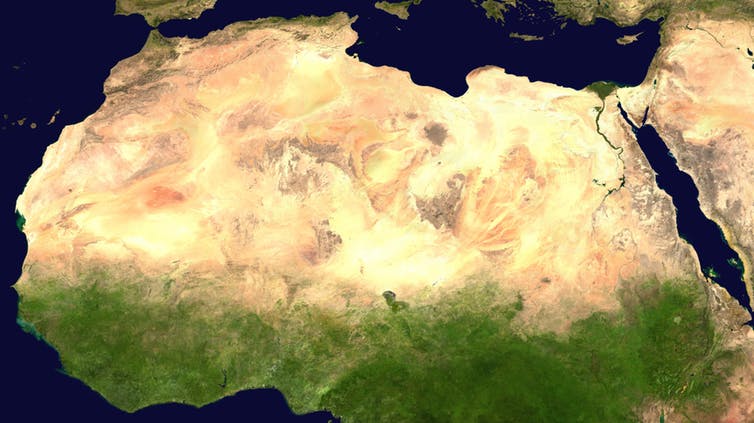
Africa’s demographic history is the hardest to reconstruct, particularly beyond the Nile Valley. Written censuses are absent, and much must be inferred from settlement archaeology, linguistics, and material culture. The Bantu migrations, beginning around the first millennium BCE, reshaped demographic patterns across sub-Saharan Africa, dispersing agricultural communities over vast regions.10 Population growth here is measured not in precise figures but in the spread of language families and iron technology.
Along the coasts and across the Sahara, demographic centers emerged where trade flourished. Carthage, before its destruction in 146 BCE, may have supported hundreds of thousands, sustained by grain surpluses from North Africa. Later, Axum in Ethiopia became a hub of population and commerce, while the Sahelian kingdoms of Ghana and Mali grew through control of trans-Saharan routes.
Even without numbers, the rhythm is visible: density clustered around trade and agriculture, with pastoral and nomadic populations maintaining lower but steady figures across the savannah and desert. Africa reminds us that demography is not only a matter of numbers but of distribution.
The Pre-Columbian Americas
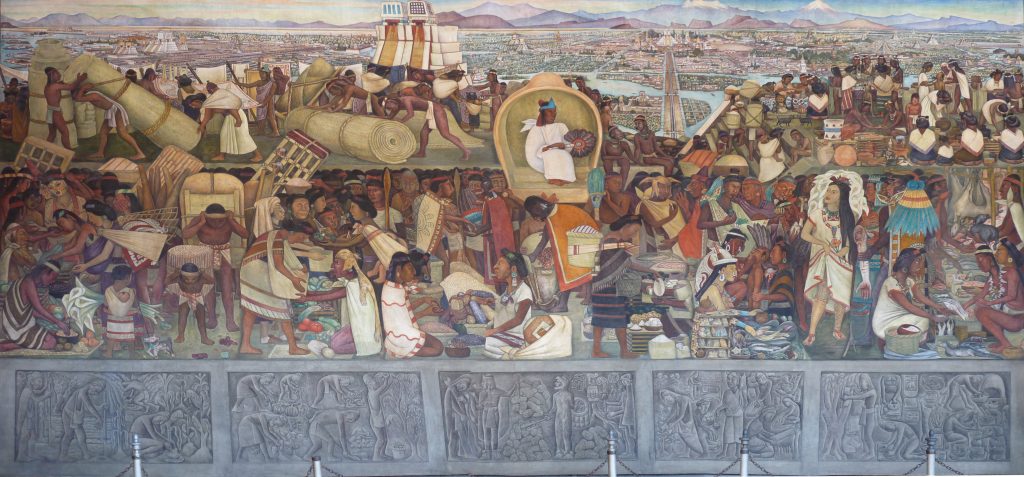
Mesoamerica reveals striking demographic achievements. Teotihuacan, at its height around 500 CE, may have housed 100,000 to 200,000 inhabitants, rivaling many Old World cities.11 Later, Tenochtitlan astonished Spanish observers with its scale, perhaps 200,000 to 250,000 people at conquest. Such numbers were sustained by intensive maize agriculture, chinampa systems, and tribute networks.
In the Andes, the Inca Empire organized populations through labor drafts and census-like records kept on quipus. Estimates for the empire’s population range from 6 million to over 10 million, reflecting both the productivity of terracing and irrigation and the difficulties of mountainous terrain.12 Highland Peru reveals dense settlements interwoven with ecological adaptation, a demographic feat unmatched elsewhere in the Americas.
North America, though less urbanized, supported significant centers. Cahokia, near present-day St. Louis, may have reached 15,000 to 20,000 people in the twelfth century, making it the largest settlement north of Mexico. Smaller pueblos and mound-builder communities demonstrate regional density supported by maize agriculture.
The greatest challenge lies in the limits of evidence. Unlike Rome or Han China, pre-Columbian societies left few written censuses. Archaeology supplies much, but the numbers remain contested. Debates over the pre-contact population of the Americas swing widely, from 40 million to over 100 million. What matters is less the precision than the recognition that the Americas supported vibrant, populous civilizations long before European arrival.
Dynamics of Population Growth and Decline
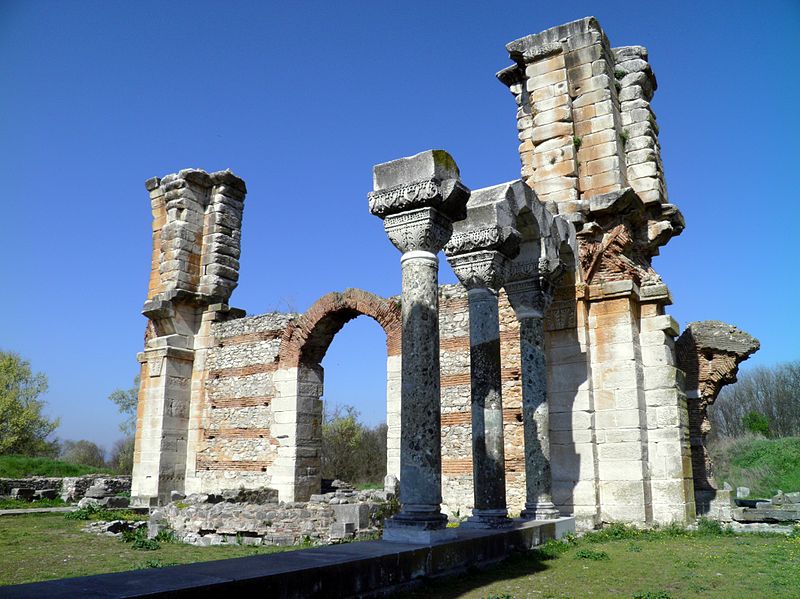
The ancient world was always precarious. Fertility was high, but so were mortality rates. Families often had many children, yet only a fraction survived into adulthood. Plagues could devastate whole regions: the Antonine Plague in Rome, the Justinianic Plague in Byzantium, outbreaks of smallpox in China, and later the cataclysm of Old World diseases in the Americas after contact.
Environmental limits also checked growth. Soil exhaustion, deforestation, and the unpredictability of rainfall curtailed demographic expansion. Famine could strike even during relative peace, resetting population levels downward. War added another layer: conquest might depopulate cities, enslave survivors, or scatter rural communities.
Yet growth did occur. Agricultural innovations (iron plows in China, improved irrigation in Mesopotamia, chinampas in Mexico) allowed populations to expand. What emerges is not steady upward growth but cycles of rise and decline, with periods of expansion followed by dramatic contraction. Ancient demography is a story of resilience amid fragility.
Comparative and Thematic Reflections
The comparison between Rome and Han China remains irresistible. Both empires counted populations in the tens of millions, both developed bureaucracies that depended on census data, and both experienced dramatic demographic shocks from war and disease. Their parallel trajectories reveal how imperial power and demography reinforced one another.
But the Americas and Africa remind us that state power is not the only driver of demographic growth. Population density could emerge in trade hubs, agricultural cores, or ecological niches without centralized empire. Demography, in other words, reflects both the power of states and the adaptability of communities.
A final theme is fragility. Ancient populations lacked the buffers of modern medicine or technology. Growth was possible, but so was sudden collapse. To count the ancients is to be reminded of how narrow the margin was between expansion and disaster.
Conclusion
The demographics of the ancient world resist precision, but broad patterns emerge. Populations clustered around fertile valleys, river systems, and urban hubs. Growth was cyclical, fragile, and profoundly shaped by ecology, politics, and war. What numbers we have are less important than the rhythms they reveal.
To measure ancient populations is to glimpse both possibility and vulnerability. Civilizations rose to remarkable heights of density and urbanization, yet they did so within limits that could quickly unravel. The act of counting itself, imperfect though it may be, reminds us that human history is not only a story of rulers and battles but also of the millions whose lives created the foundations of ancient societies.
Appendix
Footnotes
- Bruce Trigger, Understanding Early Civilizations (Cambridge: Cambridge University Press, 2003), 78–82.
- Walter Scheidel, Death on the Nile: Disease and the Demography of Roman Egypt (Leiden: Brill, 2001), 45–48.
- Tim G. Parkin, Old Age in the Roman World: A Cultural and Social History (Baltimore: Johns Hopkins University Press, 2003), 23–26.
- Marc Van De Mieroop, A History of the Ancient Near East (Oxford: Blackwell, 2003), 122–125.
- Barry Kemp, Ancient Egypt: Anatomy of a Civilization (London: Routledge, 2006), 138–140.
- Josiah Ober, Mass and Elite in Democratic Athens (Princeton: Princeton University Press, 1989), 102–105.
- Walter Scheidel, Rome and China: Comparative Perspectives on Ancient World Empires (Oxford: Oxford University Press, 2009), 56–59.
- Romila Thapar, A History of India, Volume 1 (London: Penguin, 1990), 86–89.
- Mark Edward Lewis, The Early Chinese Empires: Qin and Han (Cambridge: Harvard University Press, 2007), 72–74.
- Christopher Ehret, The Civilizations of Africa (Charlottesville: University of Virginia Press, 2002), 146–150.
- George L. Cowgill, “State and Society at Teotihuacan,” Annual Review of Anthropology 26 (1997): 129–161.
- Terence N. D’Altroy, The Incas (Oxford: Blackwell, 2002), 211–214.
Bibliography
- Cowgill, George L. “State and Society at Teotihuacan.” Annual Review of Anthropology 26 (1997): 129–161.
- D’Altroy, Terence N. The Incas. Oxford: Blackwell, 2002.
- Ehret, Christopher. The Civilizations of Africa. Charlottesville: University of Virginia Press, 2002.
- Kemp, Barry. Ancient Egypt: Anatomy of a Civilization. London: Routledge, 2006.
- Lewis, Mark Edward. The Early Chinese Empires: Qin and Han. Cambridge: Harvard University Press, 2007.
- Ober, Josiah. Mass and Elite in Democratic Athens. Princeton: Princeton University Press, 1989.
- Parkin, Tim G. Old Age in the Roman World: A Cultural and Social History. Baltimore: Johns Hopkins University Press, 2003.
- Scheidel, Walter. Death on the Nile: Disease and the Demography of Roman Egypt. Leiden: Brill, 2001.
- Scheidel, Walter. Rome and China: Comparative Perspectives on Ancient World Empires. Oxford: Oxford University Press, 2009.
- Thapar, Romila. A History of India, Volume 1. London: Penguin, 1990.
- Trigger, Bruce. Understanding Early Civilizations. Cambridge: Cambridge University Press, 2003.
- Van De Mieroop, Marc. A History of the Ancient Near East. Oxford: Blackwell, 2003.
Originally published by Brewminate, 09.17.2025, under the terms of a Creative Commons Attribution-NonCommercial-NoDerivatives 4.0 International license.


